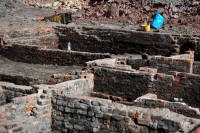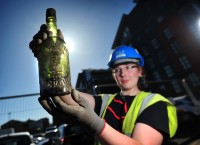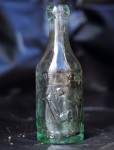 There are many old pubs in Britain. Interruptions in service, moves, rebuilds make it ambiguous which is the oldest, but there are candidates in the running that are literally ancient, like 6th century ancient, and the Feathers Hotel, the oldest continually licensed pub, dates to 1619 and incredibly still has its original wooden facade. So within that venerable context, a pub from the early 19th century isn’t all that remarkable in and of itself.
There are many old pubs in Britain. Interruptions in service, moves, rebuilds make it ambiguous which is the oldest, but there are candidates in the running that are literally ancient, like 6th century ancient, and the Feathers Hotel, the oldest continually licensed pub, dates to 1619 and incredibly still has its original wooden facade. So within that venerable context, a pub from the early 19th century isn’t all that remarkable in and of itself.
Manchester is a city of a half a million people today and while it can trace its history back to the 1st century when it was founded as a civilian settlement attached to the Roman fort of Mancunium, for almost 1,800 years it was a small country market town. It wasn’t even a city until 1853. Industrialization made the difference. Manchester exploded in the 19th century when it became a center for cotton processing. In the three decades between 1820 and 1850, the rural hamlet became an urban metropolis bristling with smoke-belching factories and mills.
 What make the discovery of the ruins of an early 19th century pub in Manchester’s city center is that so few structures from that period survived the rapid change brought on by the Industrial Revolution. Archaeologists found the foundations and walls of the pub and a bank vault during a survey of a site on the corner of Port Street and Great Ancoats Street where a skyscraper is slated to be built. That there was anything left at all of buildings from the Napoleonic era in downtown Manchester was surprise enough, but then they also found a great many artifacts that included names of people and the pub throughout its history. More than 20 glass bottles survived, some in excellent condition, three or four them still full of booze. (Brandy, apparently.)
What make the discovery of the ruins of an early 19th century pub in Manchester’s city center is that so few structures from that period survived the rapid change brought on by the Industrial Revolution. Archaeologists found the foundations and walls of the pub and a bank vault during a survey of a site on the corner of Port Street and Great Ancoats Street where a skyscraper is slated to be built. That there was anything left at all of buildings from the Napoleonic era in downtown Manchester was surprise enough, but then they also found a great many artifacts that included names of people and the pub throughout its history. More than 20 glass bottles survived, some in excellent condition, three or four them still full of booze. (Brandy, apparently.)
Historians know which pub it is because it was still functioning as such until 1928. Opened in 1821 as The Astley Arms, the pub was renamed the Paganini Tavern in 1840, returned to the Astley Arms the next decade before ending its century-long run as Cornbrook House. The building remained standing. It was restored and partially reconstructed in 1986, but eventually was demolished leaving a vacant lot.
Aidan Turner, supervisor at the site and senior archeologist, said it was exciting to be able to link the findings to living people today.
He said: “We found pottery and bottle from the Astley Arms which actually has the name of the proprietor Thomas Evans, and the name of the pub written on it, so it must have been a commissioned piece for the pub.
“It’s brilliant because you can suddenly connect it to the local people in the area. We looked online about his family history and one of his descendants now lives in Texas.
 I hope they contact the Texan descendant before the site is covered back up and the 13-story skyscraper is built on top of it. Some of the artifacts will go on display in Manchester’s Museum of Science and Industry. (I’m partial to the handsome glass bottle with the workman’s arm emblem, traditionally a symbol of manufacturing and industry seen on everything from the Great Seal of Wisconsin to mechanic signs to the logo of the Socialist Labor Party of America, but probably best known in the United States as one of the most enduring corporate logos of all time: Arm & Hammer baking soda.) What happens to the rest, including that ripe old brandy, is up to the property owners.
I hope they contact the Texan descendant before the site is covered back up and the 13-story skyscraper is built on top of it. Some of the artifacts will go on display in Manchester’s Museum of Science and Industry. (I’m partial to the handsome glass bottle with the workman’s arm emblem, traditionally a symbol of manufacturing and industry seen on everything from the Great Seal of Wisconsin to mechanic signs to the logo of the Socialist Labor Party of America, but probably best known in the United States as one of the most enduring corporate logos of all time: Arm & Hammer baking soda.) What happens to the rest, including that ripe old brandy, is up to the property owners.